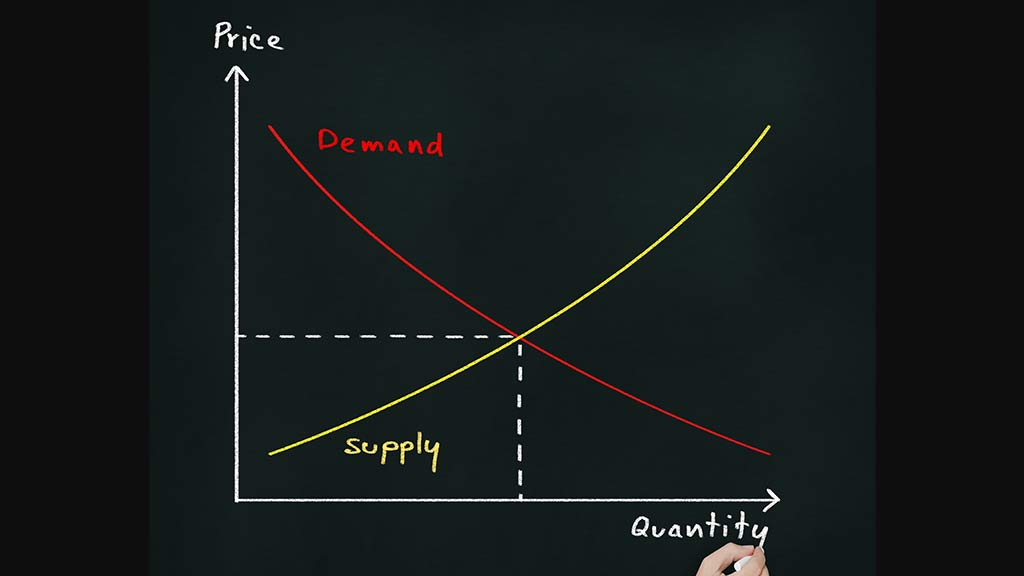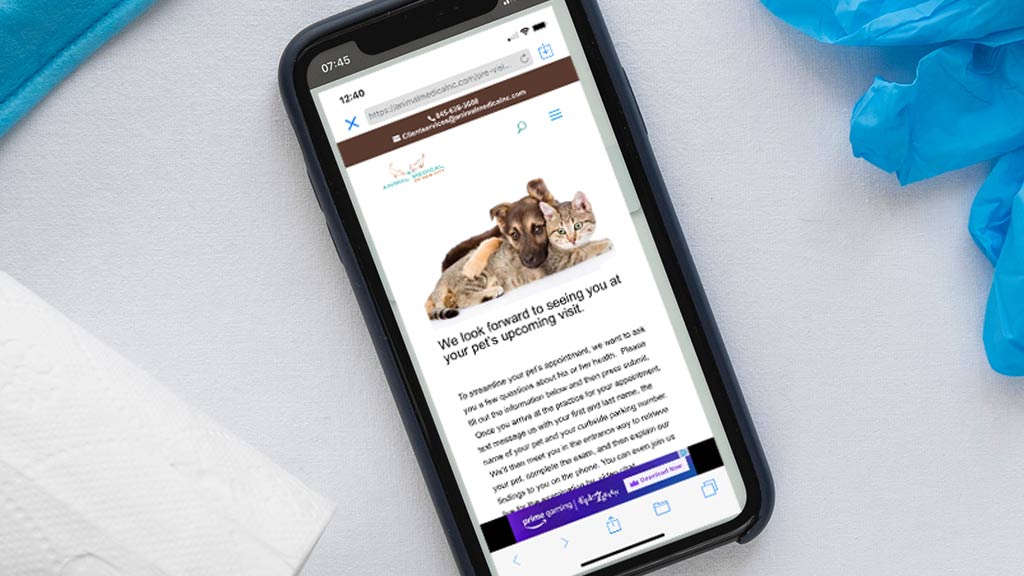Revised workflow protocols and internal communication guidelines are reducing stress in some well-managed veterinary practices. Here’s more on what these hospitals are doing.
Encourage Empathy and Compassion
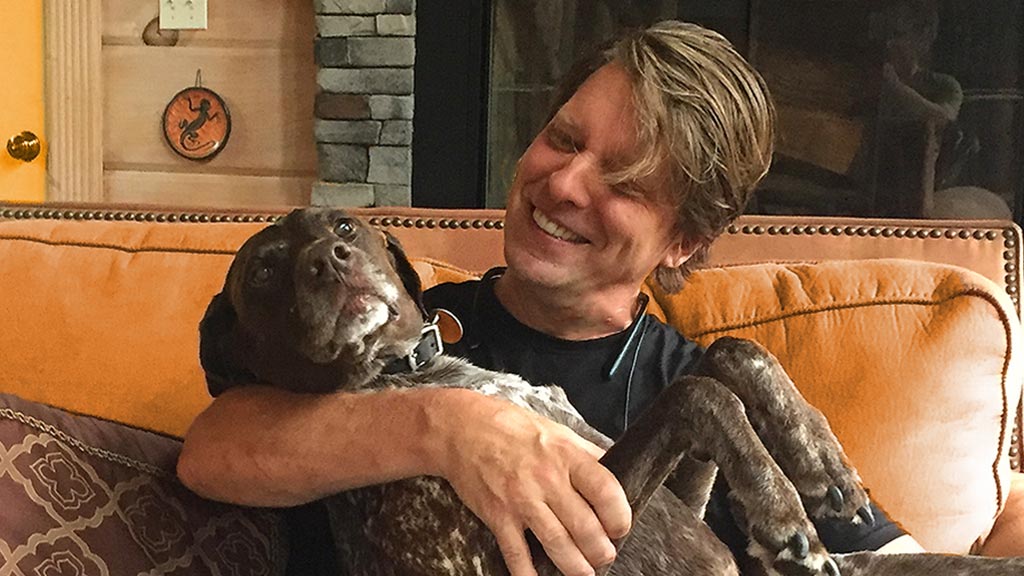 The Pandemic walloped everyone. Depression rates are up by 25%, so are bad habits like drinking and drugging. Veterinary professionals report compassion fatigue, but I wonder to what extent they haven’t misdiagnosed burnout (depression + physical fatigue) for what feels like a bankruptcy of compassion.
The Pandemic walloped everyone. Depression rates are up by 25%, so are bad habits like drinking and drugging. Veterinary professionals report compassion fatigue, but I wonder to what extent they haven’t misdiagnosed burnout (depression + physical fatigue) for what feels like a bankruptcy of compassion.
In almost all cases, compassion is not a negative contributing factor in our lives and we don’t benefit by dialing it back. On the contrary, in addition to being a reasonable expectation in a career that has us fixing serious medical issues of the ‘babies’ of self-proclaimed ‘pet parents’, compassion is a proven source of happiness, engagement, increased success of medical outcomes, more tightly knitted teams, competitive businesses, and, when turned inward and showered on ourselves, a source of personal growth, wellbeing, and reduced anxiety. Review all the reasons why we benefit from compassionate behavior with this link.
Put A Lid On Venting
Most of us have been conditioned to believe that venting is a good thing, that it helps us alleviate stress and feel better. In fact, there are good ways and bad ways to vent and veterinary teams almost always do it the wrong way.
Venting is a cry to be understood, validated, and dare I say, loved. It’s our way of asking for hug, but afraid of looking uncool, we spin it as a slug at someone else.
Think of someone asking, “Is it me or are all clients complete idiots?” as translating to mean, “Does anyone around here appreciate how hard I’m working?” If we understand that venters want affirmation that they are valuable instead of confirmation that the world around them is awful, we can cut through the raving and give them more lasting emotional sustenance.
Take Control of Grumpy Clients With Empathy and Expertise
Look, these are tense times; we’re Duct Taping airline passengers into plane seats these days, so it’s to be expected that our usually high strung clients are super strung out by the time they arrive at our door. Acknowledging that the obnoxious behavior of these pet owners, while not civil, may be understandable, will go a long way in calming things down. In short, grumpy clients should get a hand on the shoulder, not a slap on the wrist. Start with a willingness to listen and to be empathetic. It will dial down the degree of the confrontation considerably.
Next, respectfully take charge of the situation. When I first started in veterinary medicine, I believed that better service meant more bowing and scraping. Now I believe that the more we bow down, the more likely we’ll be walked over. Instead, listen to what the client needs, and then tell them what you think is best. Skip options. Options just prolong the discussion and worse, usually show that you’re not invested in the outcome. Many consumers respond to a compassionate, but firm hand. Listen to their needs, tell them what you think is best to do, then wait to see how they respond. Options, more discussion, and whatever else you need to do should all come secondary to those three steps: 1) Listen. 2) Share your honest thoughts. 3) Wait for a response.
Cultivate a Can-do Attitude
Victimhood culture is on the rise in the American workforce, so is risk aversion. It’s visible as team members increasingly retreat from problems into the security of routine, structure, and the vapid, empty calories of cell phone distraction. But veterinary leaders that cave into the notion that healthcare can, or even should, unfold in a tidy, orderly setting are not only supporting an unrealistic notion of what our business can or should be, but they are shortchanging their team members of personal growth, engagement and learning, and their businesses of long term competitiveness and success.
Humans are hardwired for problem-solving. Dreams, pattern recognition, foresight, abstract thinking, and the ability to pass information along through oral and written histories are not icing on our evolutionary cake, but essential ingredients that helped cooked our species into its current spacefaring, atom-splitting, electriclight-lit form. If your team is reluctant to solve problems, it’s unlikely due to an inability to fix an issue, rather it has something to do with what happens when they try to fix an issue. Whatever the case, encouraging employees to show up and stand up to everyday practice problems is a gift to both your business and your team.
Revisit Payment Options
Clients’ inability to pay for treatment is a perpetual flashpoint. It is essential that you and your team regularly discuss your successes and failures with helping clients navigate the emotionally fraught topic of paying for veterinary care. In additional to helping one another talk about options, know what they are. Here are three standouts that have helped many practices and pet owners.
Vetbilling.com
Vetbilling is a family-owned, veterinary-payment, installment company that has enjoyed steady growth built solely on impeccable ethics, near-total customer satisfaction, innovation, and a support team that builds trusting relationships with its clients. Vetbilling´s business model is unique in that veterinary hospital clients are not charged any financing fees. Moreover, there are no limits on who can or cannot be approved. Practices are free to write payment plans on any terms they choose. It’s an excellent product for those hospitals that want the liberty of extending credit to clients who might not appear credit worthy on paper but who have a trusting relationship with the business. Best of all, Vetbilling manages the collection of all payments so veterinary team members never have to assume the role of debt collector or bad guy. In addition to payment plans, they also offer pet health savings accounts and wellness plans. They are currently offering any referrals from this site a 60 day free trial period.
Snout Wellness Plans
Snout wellness plans are remarkable in that they finance all of the wellness care for clients. Once the client is signed up for the 12 month plan, hospitals can deliver wellness care and receive payment for that care by Snout within 48 hours. In the meantime, Snout takes responsibility for collecting the monthly payments and the risk of default! Snout offers free 15-minute zoom conferences so that you and your management team can get a fast, but thorough understanding of what they do.
CareCredit
Still an industry standby after all these years. CareCredit has the benefit of longevity in the marketplace, a product that can be used by the pet parent for both animal and human care, and assistance in helping new clients find veterinarians in their area that accept the CareCredit card.
SignaPay
This company deserves an honorable mention, not because it makes payment easier for the client, but because it makes payment easier for you. SignaPay is a payment processing company that understands an embarrassing truth about the credit card industry: to encourage credit card purchases, Visa, Mastercard, and American Express are giving away loyalty points and you’re paying for it. That’s why, at the end of the year, your 1M dollar business has racked up $25,000 in credit card processing fees. SignaPay provides free terminals and team education to painlessly hand this fee back to the consumer and keep those CC processing fees in your pocket, not the ones of the credit card industry. Use this link to learn more.
Reduce Redundancy of Communication
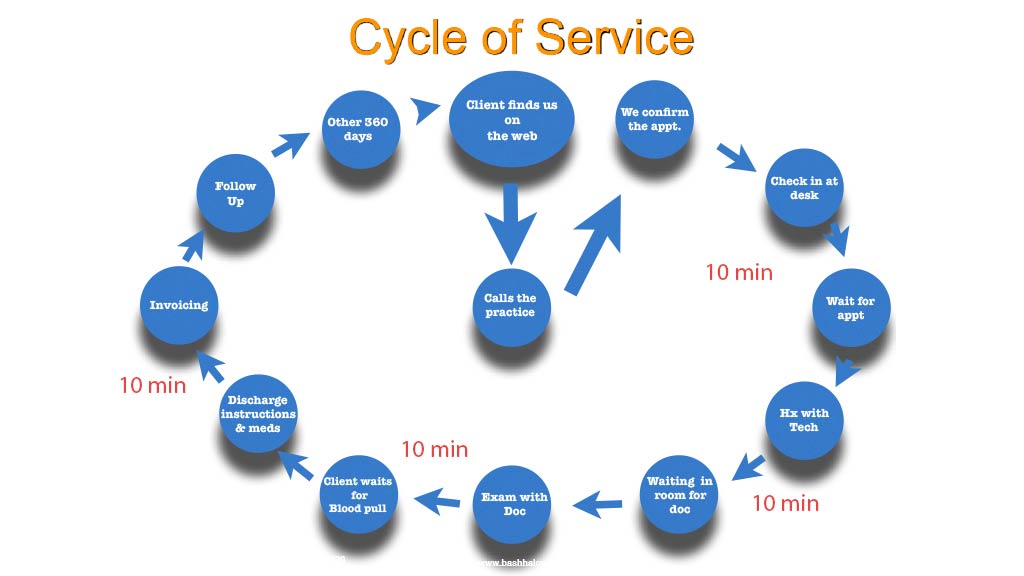
Times shown are estimates, but do your own study as a team. Review 1) The time invested in each step, 2) the necessity/value of each step, 3) the client’s sense of service in such a cycle.
I understand that the above protocol was designed to systematize the outpatient experience, and it’s clear that there are some advantages to such a system (makes for a more straight-forward training process, makes for clearer employee expectations, etc.), but usually it drags on efficiency. Worse, from a client’s perspective, the service experience ends up being pockmarked with a bunch of starts and stops. How many times is a client asked to repeat herself? How many times does a client have to start another relationship with a new employee (receptionist, technician, doctor, assistant, another receptionist)? Finally, how much time is consumed communicating to other team members what was done or what needs to be done? No, this go-to cycle of service was a nice try, but it needs to be taken back to the drawing board and redesigned.
Hospitals are using a Fortune 500 approach to workflow design. Find out more.
$1000.00
$1000 referral fee for veterinarian applicants. Sign on bonuses also available. More.
When improving the cycle of service, practice teams have focused on changes in two areas:
- Improved efficiency with use of technology
- A big change in the way that outpatient appointments are seen. Let’s look at both.
Improved Efficiency With The Use Of Technology
Phone Trees: In the before times, phone trees were a turnoff to many clients, but now that practices are short of team members and inundated with calls, phone trees have become essential in streamlining the work of your client care reps. To make them more appealing to clients, try these ideas:
Skip the long intro: “Welcome to Happy Trail Animal Hospital. We’re so glad you called…” It’s just noise. Cut to the chase. “You’ve reached Happy Trail Animal Hospital, if this is a medical emergency press 1…”
Record the message with a familiar voice: Don’t use the generic voice that comes with your phone package. Record the voice of the practice owner or a familiar one of the team.
Direct clients to the website when possible: “Want to schedule an appointment? Go to our website and click the ‘Schedule an appointment’ icon at the top of the page.” Having an automated way for clients to schedule their own appointment will prevent the tedious step of your CSRs having to check a message, call the client back, coordinating the schedule, etc.
Two-way texting: Communicate in real time with clients using the app on your phone or on the desktop of your business. Your personal phone number is never revealed to the client and you have the ability to send automatic ‘We’ll get back to you soon’ messages when it’s after-hours so you can improve your team’s work/life balance.
Previsit electronic surveys: Don’t waste time getting a verbal patient history. Send the client an electronic form that can be filled out on any device and sent to the email inbox of your choice. There’s no printing or scanning; the client just touches a link on their phone, tablet, or desktop, fills out the form, and sends it on its way. Because the form is built in conditional logic, you’ll only need to build one form which then adjusts itself based on the client’s responses. Sound beyond your technical abilities? It’s actually easy as pie. You can refer to how to build an electronic history form for your veterinary practice for more information.
Automated Medical Records Requests: Busy client care representatives or clients can use some apps to set up a medical records request prior to their appointment. Thereafter, the company automatically sends a gentle email reminder to the referring vet to complete the medical records transfer.
One-touch Pay: Who wants to touch a germy credit card these days? One-touch pay allows you to send a link to the client’s handheld or desktop device. Through the link, the client can enter their own credit card information and pay for their visit. Think of the time that saves your practice team or how much one-touch pay has increased your own online shopping and brand loyalty.
Automated Appointment Confirmation: I hope you aren’t still doing this manually. Busy practices can waste as much as an hour per day working their way through appointment confirmations. Through many telemedicine apps and most veterinary software applications, all of this is automated.
Automated Check-in and Check-out: Clients no longer have to announce their arrival to a client care representative who may already be juggling three to four tasks. Automated check-in-and-out means that clients use the app to announce their arrival to the whole team and that their method of payment is already loaded and ready for charge out. This service has been a boon for those practices still doing care curbside.
Lose The Paper: Stop asking clients if they want a printed invoice. Instead conclude the visit with, “That’s it! I already emailed you an invoice so you have all your receipts in one place. Of course, I´m happy to print you one if you need it, otherwise, we’ll see you Wednesday at 3pm for Bingo’s next appointment. That information too is on the bottom of the invoice I sent to you.” If you have a patient management software like Cornerstone, all of this can be automated.
Automated Rx Refills: Many telemedicine/ veterinary communication apps aim to keep pharmacy sales in-house with push notifications to clients alerting them when their pet’s medication needs refilled, and then giving them a chance to order and pay for their pet’s meds through the practice’s online pharmacy with a push of a button.
Push Notifications: These are pop ups that you get on your cellphone. Push notification have an almost 100% read rate, far better than any other type of communication including email and postcards.
Change The Way You See Outpatients
As a technician, I’ve started my fair share of outpatient appointments. I loved it. I loved meeting the pet and pet owner, learning more about the presenting complaint, and doing what I could to ensure an efficient exam when the doctor came into the room. As a business advisor, I’ve seen countless outpatient appointments done this way. I’ve also had a chance to watch doctors and technicians, sometimes with an assistant in tow, start appointments all at once. To my chagrin, the latter is dramatically more efficient and a better overall client service experience. Here’s how veterinary offices see outpatients as teams instead of incrementally in a series of visits by various medical professionals.
Have a technician greet the client and escort them to the exam room: Having already filled out the electronic medical history form and checked themselves in using the above-mentioned technology, the client is met at the practice door by an assistant or technician and taken directly into an exam room where a doctor is waiting. This skips the time-wasting steps of the client checking in at the desk and warming the lobby bench.
Have the doctor meet the client in the exam room: When the client enters the exam room, have her met by the doctor, a technician, and (if you have enough team members) a veterinary assistant. Having read the medical history questionnaire, the doctor should be ready to start the examination straight away. The assistant takes her position as holder for the animal, and the technician serves to record all findings in the electronic medical history and to anticipate the needs of the vet by preparing things like instruments, medications, vaccines, etc.
Doctor announces medical plan to everyone present: No need to repeat herself; everyone who needs to know the next stepst are present in the room. The doctor announces the plan, charges the technician and the assistant with all the treatment orders, thanks the client, and leaves to prepare for the next exam.
Technician and assistant complete examination: Both team members complete as many of the treatments as they can in the exam room including blood draws and injections. Additionally one will briefly excuse herself to fill meds or interface with a floater in the pharmacy to do so. Back in the room, the tech or assistant will invoice the client, schedule any additional appointments, and take payment for the visit using wireless card readers or links that allow the client to pay through an app. Once the payment is complete, the client can collect her pet, the pet’s meds, her personal belongings and then exit the building without stopping at the front desk, usually another step that is fraught with hiccups, confusion and unnecessary delays.
Sound too complicated? Nope. Most all of this can be easily managed with the integrated technology of companies like Idexx or many of the apps on the market.
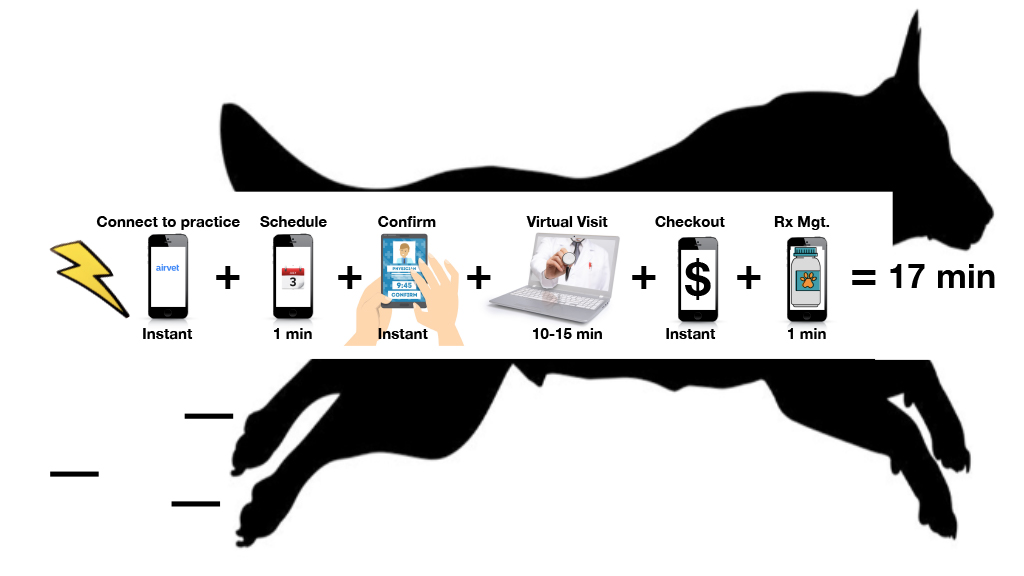
A number of tech tools and changes to workflow can shave off a lot of time to the outpatient appointment. Learn more about time saving technology.
Take Control
We’re in agreement that these are stressful times, but we don’t have to be victimized by what’s happening around us. Things aren’t so bad that we don’t have considerable control of our behavior and our workplace. As a business leader, help your team make healthy communication choices and then work together to figure out a streamlined path to more efficient and productive work. Nearly everyone is gratified by completing a job successfully. Though you may be busy, if you find a way for individual team members to finish their work and succeed, you’ll mitigate stress and improve job satisfaction.





